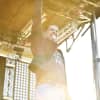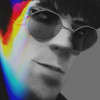It wouldn’t be wrong to call Jayson Musson a renaissance man. For over a decade, the New York-born, Philadelphia-educated artist has had his hand in every contemporary creative medium, from his 2007 "Black Like Me" column for the Philadelphia Weekly to his avant-garde, throwback hip-hop group Plastic Little, whose "Miller Time" single became like the unlikely source material for Baauer's booty-shaking meme-jam "Harlem Shake" this year. I first became aware of Musson via Hennessy Youngman, the fictional alter ego he plays in his Art Thoughtz YouTube series, preaching art history in an urban vernacular that parodies centuries-old, overused academic art references. The videos have achieved a type of cult status, making Youngman (if not Musson) a household name.
Two years ago, Musson moved to New York after finishing his Masters in painting at the University of Pennsylvania. Last year, he had his first major solo show at Salon 94. Like Art Thoughtz and its critique of contemporary art-speak, the series of Coogi sweater-inspired paintings he presented at that exhibition took a widely accepted status symbol—a brand of Australian pullover, rocked by hip-hop trailblazers in the '90s—and turned it on its head. I caught up with the artist a few weeks ago, only to learn he has again switched platforms, this time working on a children’s book that satirizes contemporary politics. As with everything else he’s touched, the project, titled The American, seems solid gold. Then again, it's likely just a phase.
You're from New York, but you grew up in Philadelphia. How do the two cities compare? My grandparents live in the Bronx, and my dad lives in Queens, so I grew up there. I lived in Philly as a teenager until my early thirties. I love Philly; it's a shithole. They have great parties; I actually go down there to go to parties. I have keys to my old apartment and I’ll go with business in mind, but just stay for three days. People there are carefree.
Did you move back to New York to get serious about art? Yes, but when I first moved, I didn’t have even have a studio. My gallery is Salon 94, and the woman who runs it owns a massive New York townhouse. I had a show there last summer, and also lived in her house. I spent an entire summer literally half a block from Central Park. That was my first summer back in New York. But you need a place to mess up. I have a studio, but I still work in every room of my house: I write and draw in the living room, I paint at the kitchen table and I’m setting up an office to draw. I like working from home.
Most people in New York seem to run high on interests and low on time. Was it easier to produce work in Philadelphia? In Philadelphia, you have much more free time as the cost of living is quite low, but having a great deal of free time doesn’t guarantee productivity. I partied like a motherfucker in Philly. I made art too, but dawg, I got it in. In NYC, because time is so scarce, I think people here are more aware of the economy of time and treat time like a precious commodity. I think there are some benefits to that; there’s kind of a hustler’s air to NYC, which I find inspiring, but the downside of that is the absurd amount of business cards you’re prone to receive at parties. If someone gave me a business card at a party in Philadelphia, I’d head-butt them. In New York it’s, “Hey cool, thanks! I’m gonna go to the bathroom.”
When was the moment you felt you could make decisions solely as an artist, that moment when you knew you’d achieved success? “Success.” There’s a lot of ways to describe success. Some folks think it’s in money, others in attention, others in redefining your field, and others believe it lies in personal fulfillment regardless of attention or money or being a part of some vanguard. I feel like I was first successful with [the poster series] Too Black for BET (2002); it was the first body of work I made where I was truly able to input my own personality into the work, to convey my voice in a manner honest to who I thought I was at the time, which is really hard to fucking do.
How did that project begin? When I was a junior or senior, I was a computer lab monitor. It was right when the color Macs came out, but students weren’t allowed to use them yet. The head of the department was this crazy egomaniac.
Remember in school, when there were the good computers… ...Yeah, and the clunkers. We had a whole lab full of nice ones that no one was allowed to use, but I had to watch the lab. I would sit there by myself and make stickers in QuarkXPress for like four hours. I began writing more and rambling on and that’s how Too Black for BET came about. They were originally broadside posters, and when they’re exhibited, they’re three-by-five-foot Xeroxes. For a while, I never wanted to pay to make art. I was really into the idea of stealing stuff from Kinkos for shows.
The writing kind of predates your Hennessy Youngman videos. It’s decidedly frank, while taking on these very large cultural and critical ideologies. I was twenty-three. When I started writing the actual larger poster works, I had just broken up with a girl. You know how you have to break up three times to really break up with someone? Well, that shit was combusting, the relationship was failing. I think I had dreads and I cut my dreads off, just gave up on all my ideals, and that's what the piece Have You Ever came out of.
That whole series came out of a breakup? I think the posters came out of this newfound awareness of people. People are universally awful, despite their race. I’m mixed. My family has been mixed since way back, and you see the folly in the binary of black and white. Black people can be crazy and stupid, white people can be crazy and stupid. People also have a great capacity for goodness, but people can still be awful despite their race. In Too Black for BET, I was attacking notions of race and a central goodness in both races in a very roundabout and acerbic way. That’s why the tone of the book—if you don’t know who wrote it, you don’t know the race of the author. I’ll flip tones within some pieces; sometimes it sounds like a white dude writing, then I’ll devolve into slang within the same piece. I like the juxtaposition between the language of authority and more how I spoke with my friends in the same space. A lot of it just exists to fuck with people.
More and more often, so much that get’s attributed to race is a cultural difference. I think your art has always been easy to identify with for a younger generation because you don’t ignore subcultures. The Star Wars references are a brilliant example. Star Wars is a cultural mythology; its one of our modern, contemporary myths. I actually watch it once a year, if I’m feeling really depressed or I need to get my moral compass back on track. I lived with this guy for nine years—he’s one of my best friends, we were Star Wars nuts. I have the VHSs here, but they’re behind the R. Kelley Trapped in the Closet set. For me, Star Wars is a moralizing experience. Lectures and panel discussions in art are the equivalent, but I don’t go to many of those.
In 2007, you wrote the column “Black Like Me” for the Philadelphia Weekly. Do you consider yourself an artist who writes or an art writer? I refer to myself as a writer more than an artist, because I feel like I have a pretty tenuous relationship to objects. Most of my visual work stems out of words, from my Too Black for BET posters, to my Obama paintings, to the script writing that was a major component of Art Thoughtz; even my Coogi paintings began as a Tumblr post. To create an object with no relationship to language is a rarity for me.
Your character, Hennessey Youngman, in Art Thoughtz is what brought you widespread attention. How did the buzz around that project change things for you? Art Thoughtz opened up a lot of doors for me, but mainly it allowed me to share my voice with a wider audience than could be achieved through Ye Olde, static, “look at this thing I made in the place where you look at things that are made” method of yore. That’s the boon of the internet: your audience is there, they’re dynamic, and in a way, they’re you. You just have to extend a hand toward them. Nothing has been expressly bad, just annoying mostly. Like when I get a request to speak about some hyper-specific subject like, “Hi Hennessy, would you like to speak about the governor of Campania during the Herculonius period?” Sorry, that’s a Gravediggaz joke. But yeah, I’m not some wedding DJ of critical theory. I honestly don’t think about art that much. It’s pretty low on my list of interests, actually.
Your series of Obama paintings kind of predate your latest book project, The American. They’re very close in style to a graphic novel or a superhero comic. During the election in 2008, I was on tour in England and Europe and it was crazy how psyched, in general, everyone was. Europeans love Obama. I saw Obama paraphernalia in Paris and I was like, “People love this dude, and he’s an American politician!” When I created that body of work, I wanted to emphasize the amount that people trust in politicians; it’s weird to me, like they’re kids. I wanted to approach Obama’s mythology visually from the viewpoint of a child, and show peoples’ naivety and hope—that’s why I painted them to look that way. When I first made them, I painted four of them, and they were too ugly, so I shelved them. Then my friend who owns a gallery if Philadelphia saw them, and I needed him to tell me they were funny to finish the series. I normally don’t work in color, but after I started drawing like that, I realized it was fun.
What made you want to write a book at this point in your career? I make visual art, but in the end I’m more drawn to writing and story telling. I grew up reading and writing comic books as a teenager. With The American, I was never under the assumption that I was going to make a viable book. Paul Chan, the publisher at Badlands Unlimited, is an artist, so I didn’t sit down and write the book in a traditional, dramatic structure. It’s set up like a video game, where each transition in landscape is how the story progresses. The main character doesn’t learn anything, and the story ends really weirdly.
The premise of the story is based off of a character, “The American,” who I previously painted. He’s standing on top of a pile of skulls. He gets visited by the ghost of Henry Ford, and Ford tasks him with traveling across America and fixing the ills of the country. He goes to Disney World to destroy the It’s A Small World ride because it promotes pluralism; he goes to San Francisco to deal with the “homosexual scourge”; he goes to Slovenia to confront Slavoj Zizek; and then it ends in Dubai. The main character is a cross between the Little Prince and Terminator. He’s very naïve and violent, and even through he triumphs at the end, he still thinks America is still unfaultable.
Was it fun to write, compared to other projects that aren’t as demanding, based on the sheer volume of content a book takes? I wrote most of it on my phone. It’s actually really good to write a children’s book that way, because you’re very lean; you use a limited amount of words. Everything comes out in the simplest terms. A lot of art writing gets wrapped up in having to prove the history of the work, so the writing gets trapped in creating a timeline. I just kind of kills it for me. It seems the writer is a lot more interested in proving their own intelligence and their knowledge of history than talking about how they feel. I think it’s okay to be subjective—even in one’s dry, intellectual objectivity, it’s still pretty personal. When I was making the Hennessey videos, people said I was being anti-intellectual. People are trapped in a way of perceiving [certain] dialogue; it was impossible for me not to acknowledge and make fun of it there, and in The American.
What do you consider to be the piece that, from conception to execution, is your most accurately realized work? I think I may have answered this, but my most successful work is Too Black for BET; it’s morbid, but it’s honest, funny, kind of sad in a mean way, and it set the tonal ground for everything I made after that. Too Black for BET is like my Rosetta Stone in a way. Almost everything I’ve made can be deciphered through its lens. It cost nothing to make. Too Black… didn’t get lost in its object-ness; it was about the experience of traveling through the different narratives of each poster.
Are you at a point in your career where you’re happy with the work you’ve made, and how you’ve come to be represented? I feel pretty fortunate. Everything’s worked out for me so far, but it’s been a long road. I’m thirty-five. There was a lot to go through that was not pleasurable—the poverty of being in your twenties and things not working out. I’m glad I moved to New York when I did. I’ve got a Philly life here, a slow city life.


